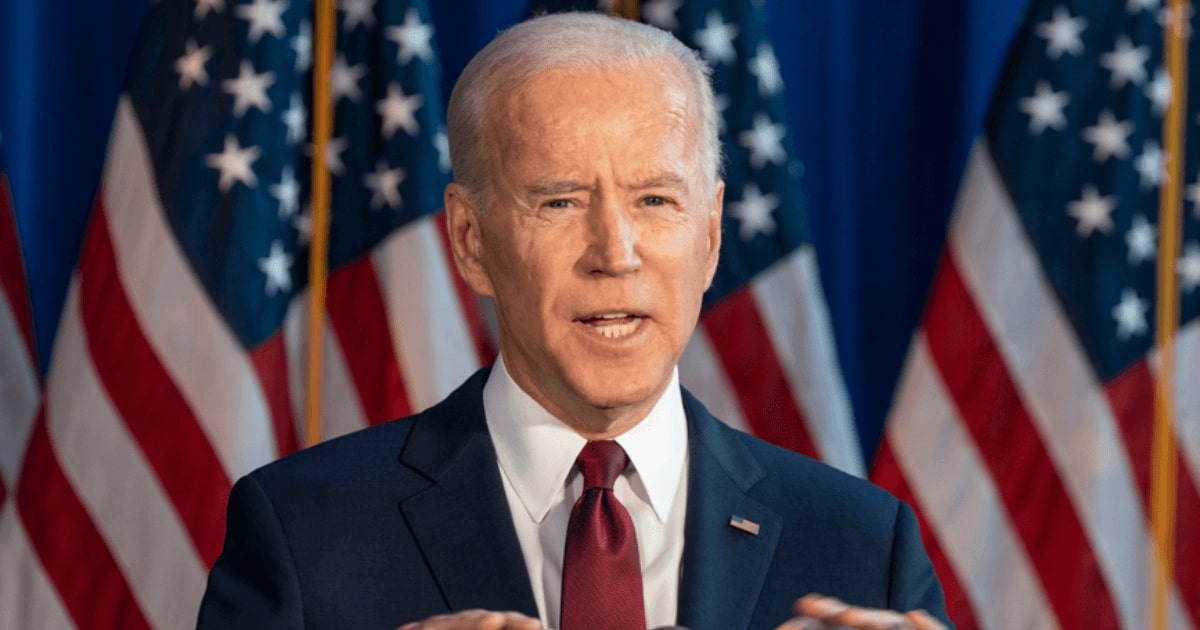Immigration: Biden’s Biggest Foreign Policy Test
Why only a Marshall Plan for Central America has a shot at dealing with the region — and why it makes political and economic sense.
April 8, 2021

Joe Biden has pledged to pursue “a foreign policy for the middle class.”
The statement acknowledges that the globalization policies of his two Democratic predecessors — Bill Clinton and Barack Obama — had alienated a large part of the Democratic Party’s political base. That, in turn, led to electing and almost re-electing Donald Trump.
An important promise to keep
With majorities in both parties now more protectionist, all indications are that the era of free trade deals pursued during the Clinton/Bush/Obama years is over, at least for now.
The real test of Biden’s promise to make foreign policy responsive to ordinary Americans’ concerns lies on the U.S. southern border.
There, surging illegal immigration from Central America is overwhelming security guards, detention centers and local communities.
Ignoring their own neighborhood?
The U.S. Secretaries of State and Defense are flying off to Asia, Europe and the Middle East, asserting that “America is back” to lead the world.
These relationships certainly need mending, but Antony Blinken and Lloyd Austin are ignoring the foreign policy crisis in their own geographic neighborhood.
After all, the root cause of the border crisis is continued U.S. support for the corrupt ruling classes in Central America who have created the oppressive conditions driving their people north.
Not a good sign
Unfortunately, President Biden never mentioned immigration in his February speech to State Department diplomats, while citing disputes with Russia and China a number of times.
Yet, the average working American cares much more about what is happening at the Mexican border than whether China or Japan control a few uninhabited islands in the South China Sea, or which hardline Russian nationalist — Putin or Navalny — rules the Kremlin.
Immigration: Trump vs. Biden battle continues
Most Americans think immigration is good for the country. But they want it limited and orderly.
And while they sympathize with the plight of poor and oppressed migrants, they do not want them entering illegally.
In March 2021, U.S. border police detained 171,000 migrants who had crossed the border illegally. Another estimated 30,000 escaped detection.
Trump, the exploiter
In his time in the Oval Office, Donald Trump exploited that fear with policies that were racist, xenophobic, inhumane — and very clear: Build a wall to keep them out. And if they get here, treat them rough and throw them back.
For a while, his hardline approach did cut down on crossings, leaving thousands of migrants stuck in squalid camps on the Mexican side of the border. But last fall, with Trump still in office, the numbers began to rise again.
Democrats: Torn in two directions
Democrats are not so clear. Because they are more dependent on votes of Latino-Americans, they show more compassion for the migrants.
Joe Biden is thus trying to improve conditions. He has also promised not to deport children and is allowing many more migrants to remain in the United States, while their status as refugees is determined.
But the Democrats at present have no strategy for keeping the United States’ Southern border secure. Indeed, in response to Biden’s more open-hearted approach, more Central Americans are coming.
In February, over 100,000 — including 30,000 unaccompanied minors — crossed the border illegally. The March numbers will be higher.
A foreign policy issue
Both parties treat the issue of illegal immigration primarily as a domestic problem. That fight is over what to do with migrants when they get here.
In contrast, efforts to address the conditions causing migrants to flee their homes have been marginal, contradictory and ineffective.
Biden recognizes that the problem does not begin at the border. So he proposes to double U.S. development aid to Central America.
He has tasked Vice President Kamala Harris to “work with” governments there to channel the funds to non-government civil society.
Same failed policies
However, the U.S. government has been putting money into the region ever since John Kennedy announced his Alliance for Progress back in 1961. And since 1990, most of it – sensibly enough – has been directed at NGOs.
To be sure, the U.S. AID agency has supported some useful projects – potable water, health centers and schools. But much of the aid flowing in still ends up being controlled by the government there.
The U.S.’s corrupt deal
Moreover, these efforts hardly offset the operations of the U.S. Defense and State Departments. These agencies have long supplied guns, training and political support to keep the elites in those countries in charge.
Both sides benefit. The local elites preserve their power in exchange for accommodating U.S. commercial and political interests in the region.
In this context, since 1890, the United States has intervened militarily in the region 45 separate times, generally to defend its upper-class clients.
U.S. financing chaos and crime
Today, many of the Central American oligarchs are deeply involved in narco-trafficking. It is a more profitable business and requires fewer workers than growing bananas or coffee.
Protected by their national military and corrupt judiciary, criminal drug gangs have multiplied and spread throughout the region. They have also expanded beyond the drug business to armed robbery, extortion and kidnapping. Those who resist risk violence — including murder and rape.
That, in turn, makes the daily life of ordinary people, already struggling very hard to make a living, even more unbearable.
Despite Washington’s highly publicized “war on drugs,” the U.S. government underwrites this brutal system.
Consider Honduras
To give but one concrete example: In 2009, the elected president of Honduras dared to initiate some mild education and social reforms. The oligarchs didn’t like it.
That president was subsequently kidnapped by U.S.-trained Honduran armed forces. He was taken to an U.S. military base and shipped out of the country.
The Obama Administration, for its part, publicly criticized the coup, but effectively protected it from international pressure to restore democracy.
We Americans make them emigrate
A year after the coup, the Obama administration increased aid to the corrupt, narco-infected government the military installed. When demonstrators protested in the street, military police killed at least 20.
Effectively, the message from Washington to social, political and economic reformers: “Don’t even try!”
It should be no surprise that, five years after the coup, the number of Honduran children illegally crossing into the United States increased by 1,272%. Or that polls show that at least half of that country’s ten million people want to leave.
The brother of the current military-backed Honduran president has been convicted of drug trafficking by a New York court and was just sentenced to life imprisonment.
The current president, Juan Orlando Hernández, was named a co-conspirator. A mountain of evidence revealed that the Honduran government is deeply infiltrated by criminal cartels.
The day Hernández’ brother was convicted, the U.S. ambassador to Honduras tweeted a statement praising Hernandez for his war on drugs.
Needed: A large-scale sustained strategy
Clearly, what is needed is a sustained comprehensive, adequately financed social and economic redevelopment plan for the region.
One relevant point of departure could be a letter that Mexican president Andres Manuel López Obrador wrote in 2018, right after he was elected, to then U.S. President Donald Trump
“AMLO” suggested the two countries collaborate on a Marshall Plan-type effort for southern Mexico and Central America.
Trump was of course not interested, and Lopez Obrador soon was overwhelmed with the problems of crime, COVID 19 and the effect of the U.S. recession.
Is a Marshall Plan for Latin America utopian?
Lopez Obrador’s idea was dismissed as utopian at the time. But the idea is worth a closer look.
After all, the region has abundant natural resources. What’s more, as the experience of migrants living and working in the United States underscores, it has a population that is hardworking, ambitious and eager to learn.
A geoeconomic pact worth making
The market links between the United States and its neighbors to the south are stronger than ever and growing. One indication is that the two largest freight railroad companies in the United States and Canada have just announced their intention to build a seamless rail system between the United States, Canada and Mexico.
Moreover, it is a fit with Biden’s own plans for large investments in green infrastructure in the United States. It will create foreign business opportunities that would otherwise go to Asia.
First step: Pick the right partners
No real progress is possible until the Biden Administration stops supporting these oppressive governments and allies itself with the networks of brave and persistent Central American reformers.
They are struggling to build a better society in the face of death, torture and banishment. Other natural allies are decent people in the police, military and those in the judiciary sickened by the corruption and butchery.
A clear, convincing message to them from the Biden Administration that the United States is on their side, backed with real money, a halt in military aid and meaningful sanctions against criminal and corrupt officials could be an historic game changer.
“Going Big” To deal with the root cause
The impact on illegal immigration to the United States could be felt relatively quickly. Most people leave because they have lost hope that anything will change.
Restoring that hope might well convince them that building a life at home is a better bet than watching their children grow up in a detention camp.
And it would give American voters some confidence that compassionate treatment of migrants today will not encourage more to come tomorrow.
Kamala Harris will need help
Without that clear signal, Kamela Harris, able as she is, will have no more effect on conditions in Central America than vice-president Joe Biden did when Obama sent him on a similar mission over a decade ago.
Local elites will listen politely to lectures on democracy and human rights and go back to doing business with the U.S. military and commercial consulates.
The message has to come directly and forcibly from the U.S. Secretaries of Defense and State. Blinken and Austin must make that message credible by cleaning out their own bureaucratic cultures. These shady inter-bureaucratic pacts have nurtured cronyism between American and Central American officials for far too long.
Both the United States and Central America need to make room for a new generation of officials to collaborate on the task of rebuilding the region.
Yes, a difficult task
Yes, this is an enormous task. But, given the enormous influence the United States has on Central America, it is arguably less difficult and more realistic than efforts to change history in other parts of the globe.
The odds for success there are certainly greater than for imposing more liberal human rights policies on Putin’s Russia. Or bringing political stability to the Middle East. Or rolling back China’s influence in Asia.
For the average American voter, “getting Central America right” is much more important. That includes Latino-American workers who are the most vulnerable to economic competition from undocumented immigrants.
A danger sign for Democrats is that, despite Trump’s relentless racist insults during his time in office, he actually increased his share of the Latino vote from 2016 to 2020.
Conclusions
The political stakes are high – for the United States and the world.
So far, Biden’s approval ratings are good — although they are not as good as the scores that Obama, Bush and Clinton had at a comparable early point in their presidencies.
The country thus remains deeply divided. Republicans are already attacking Joe Biden for being unable to keep the borders secure.
Democrats have only razor-thin majorities in the Congress. Historically, the political party in the White House loses seats in the next congressional election.
Thus, in less than two years, a small shift in voter opinion could put Republicans — still the party of Trump — back in control of the legislature.
Democrats paid a high price in the past for ignoring the electorate’s anxieties about illegal immigration. They should not make the same mistake again.
Takeaways
Most Americans think immigration is good for the country. But they want it limited and orderly.
Democrats paid a high price in the past for ignoring the electorate’s anxieties about illegal immigration. They should not make the same mistake again.
Republicans and Democrats treat the issue of illegal immigration primarily as a domestic problem. That fight is over what to do with migrants when they get here.
No real progress is possible until the Biden Administration stops supporting oppressive governments and allies itself with the networks of brave and persistent Central American reformers.
A clear message to Central American reformers from the Biden Administration that the US is on their side and meaningful sanctions against corrupt officials could be an historic game changer.
Both the US and Central America need to make room for a new generation of officials to collaborate on the task of rebuilding the region.

